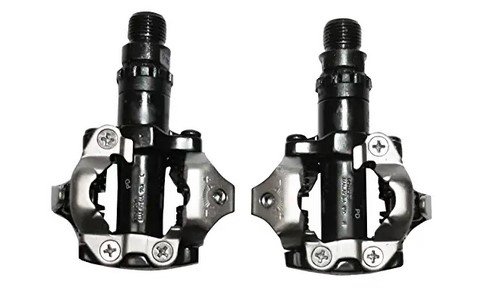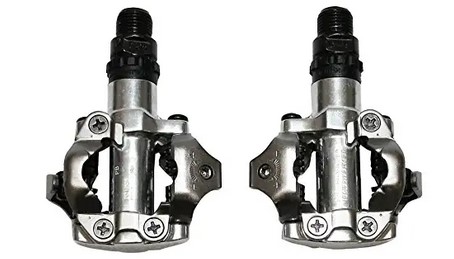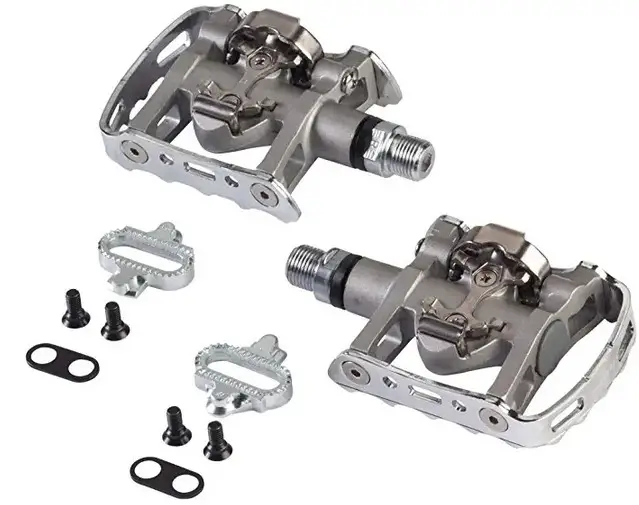Clipless pedals come in two systems: a two-bolt mountain bike style such as Shimano’s SPD-SL and a three-bolt road bike style like Shimano’s SPD. The SPD pedals (Shimano Pedaling Dynamics) are famous for clipless pedals, but are SPD pedals worth it?
SPD pedals are worth it since they let you position your legs firmly, giving you more bike control. In addition, since your feet get locked into SPD pedals when cycling, you get more power while climbing, accelerating, and all through the pedal stroke.
Additionally, they are also easy to get out and in the pedals. However, Make sure you have shoes that perfectly fit your SPD pedals and feet to fully realize these pedals’ benefits.

Are SPD Pedals Worth It? (Reasons To Use Them)
SPD pedals are popular for good reasons, so let’s take a look at the aspects that make them a worthwhile investment for you.
1) They Have Walkable Cleats
SPD pedals have small cleats, which are advantageous because you can easily walk in them when you aren’t cycling.
This is different from two-bolt cleats’ shoes seen in the SPD-SL design, which have a tread on their soles and a recessed cleat. With this design, you walk on the shoe’s grippy, large area, not the cleat itself.
Therefore, it’s better to choose SPD pedals if you intend to walk a lot as they are the obvious choice. They will make walking more comfortable and effortless.
The treads on the sole ensure you don’t slip on slippery, smooth surfaces and offer proper grip if the need to climb or walk arises during off-road cycling.
In addition, these pedals make excellent for commuting as you will put your feet down in some areas like stops. You will also need to walk to the bicycle sheds at the start and end of your commute.
You can also use them when touring to make walking around when you stop in between your journey easier.
2) They Have A Double-Sided Entry
You can clip your shoes into either side of your SPD pedals because most of them are double-sided. This makes starting your bike from a stationary position much easier.
You can adjust the cleat’s release tension with a tiny screw at the pedal’s rear side on both sides since it’s double-sided. This is an excellent quality because some cyclists prefer the extra security from raised release tension.
However, consider using less tension if you are new to SPD pedals, then move your way from there.
3) Mud Shedding
You will find that most of these pedals feature an open construction that has a large hole in the middle. This design ensures any mud stuck at the bottom of your shoes falls off, thus maintaining the pedaling efficiency or pedal engagement.
Clogging resistance and walkability renders SPD pedals great for mountain biking and cyclocross racing. They are also common among gravel bicycle riders.
Cyclists who love off-road riding should consider Shimano SPD Pedal Clipless Pedals (View on Amazon). These click pedals are made for mountain bikes, weigh 0.2 kilograms.

They should be top of your list when choosing bike pedals for winter cycling when the ground is icy, wet, or muddy. This is because you will likely have to walk at some point during the ride, and the wheels may kick muck, clogging the cleats.
The surface area of these pedals is also very small for optimum mud shedding. Moreover, putting thin shims between the shoe and cleat to optimize the pedal surface and shoe connection.
4) Durable Cleats
All SPD pedals have robust metallic cleats, so they will serve you many years before the binding surfaces wear off, leading to less secure engagement. Luckily, they are easily replaceable and don’t cost much.
5) They Keep Your Knees Safe
The pedal to shoe interface in today’s SPD pedals provides some “float,” which allows vertical axis rotation of your feet without disengaging. This translates to a comfortable ride.
Additionally, they let you swivel your feet a bit and lock the knee in a single position, preventing knee injuries from hard pedaling.
6) Biomechanical Advantages
Since you can position your feet properly on the pedals and won’t slip easily, you will get more climbing power, pedaling efficiency, and sprinting advantage.
- Pedaling Efficiency
Every stroke you make will create more power because positioning your feet firmly on the pedals makes your body and feet work harmoniously.
- Sprinting Advantage
Since your strokes generate more power with these pedals, you will be able to cycle faster. This is particularly beneficial for racing bikes.
If you enjoy riding your bike fast, SHIMANO PD-M324 SPD Dual Platform Pedal (View on Amazon) is perfect for you. It’s alloy-steel made and designed for road bikes.

- Climbing Power
Pedaling efficiency also gives you more power to overcome obstacles and climb more easily. This is why mountain bikes thrive with SPD pedals.
What Are The Limitations Of SPD Pedals
While these pedals have plenty of good qualities, they also have their shortcomings.
a) Learning How to Use Them Takes Time
It will take a couple of tries to master how to ride your bike with SPD pedals. However, the outcome will be worthwhile.
b) Less Clearance
when you add the thickness of your riding shoes and the pedals’ thickness, the ground clearance reduces. While you won’t suffer the consequences on flat ground, you will feel them on the slopes.
FAQs
1. What Does SPD Pedals Stand For?
SPD pedals, also called Shimano SPD, spud, or SPD, stand for Shimano Pedaling Dynamics.
2. Do SPD Pedals Make A Difference?
SPD pedals make bike pedaling more efficient, with every stroke providing more power than you’d get from other pedals. This translates to better sprinting and more climbing power.
You can also walk comfortably on your cycling shoes because they have walkable cleats. This eliminates the need to change your shoes every time you walk when cycling.
3. Are SPD Pedals Easier?
SPD pedals are easier to clip on your shoes because most of them are double-sided. However, it will take some time to understand how to use them.
4. Do SPD Cleats Fit All SPD Pedals?
SPD cleats aren’t universal, meaning you cannot use any SPD cleats on your SPD pedals. For an SPD cleat and SPD pedal to be compatible, they must have a similar system of bolt anchoring, which is either two or three-bolt.
5. Can You Use SPD Pedals On A Road Bike?
SPD pedals aren’t ideal for road bikes. Instead, SPD-SL pedals are perfect for road bicycles.
SPD pedals are synonymous with mountain bikes today. However, you can also use them on gravel, cyclocross, touring, or even commuting.
6. Will SPD Cleats Work On SPD-SL Pedals?
SPD cleats aren’t compatible with SPD-SL pedals because these are entirely different systems. However, SPD cleats will work with compatible SPD pedals.
7. What Is The Difference Between SPD And SPD SL Pedals?
SPD (Shimano Pedaling Dynamics) and SPD-SL (Shimano Pedaling Dynamics SuperLight) are both clipless pedals. However, SPD pedals are typically used in mountain bikes, while SPD-SL pedals are for road bikes.
SPD cleats are metallic and use two bolts. On the other hand, SPD-SL cleats are bigger than SPD cleats, use three bolts, and are made of plastic.
8. Can You Put SPD Pedals On A Peloton?
You can install SPD pedals on your peloton because most pedals that work with Peloton bicycles belong in the SPD cleats system. However, ensure the spindle thread matches the crank arm.
In Conclusion, Are SPD Pedals Worth It?
SPD pedals are undoubtedly worth it as they make cycling more efficient and comfortable. Their biomechanical advantages make climbing and riding faster more effortless.
Moreover, you don’t have to worry about mud sticking on your pedals because they employ an open construction.
Also, read: Do Pedal Straps Work?
